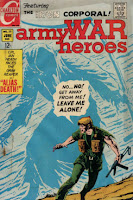Publisher: Charlton
Publication Dates: December 1963 – June 1970
Number of Issues Published: 38 (#01 – #38)
Color: Color
Dimensions: Standard Silver Age US Size
Paper Stock: Newsprint
Binding: Saddle-stitched
Publishing Format: Was ongoing
Authors:
Script: Joe Gill?
Pencils: Dick Giordano?, Charles Nicholas (signed), Bill Molno, Pat Masulli?,
Larry Woromay
Inks: Dick Giordano, Vince Alascia (signed), Rocco "Rocke" Mastroserio (signed),
Silver Age
The company's most noteworthy period was during the Silver Age of comic books, which had begun with DC Comics' successful revival of superheroes in 1956.[2] In March 1960, Charlton's science fiction anthology title Space Adventures introduced Captain Atom, by Gill and the future co-creator of Marvel Comics' Spider-Man, Steve Ditko.(After the mid-1980s demise of Charlton, Captain Atom would go on to become a stalwart of the DC stable, as would Blue Beetle, the old Fox Comics superhero revived by Gill and artists Bill Fraccio and Tony Tallarico as a campy, comedic character in Blue Beetle #1 [June 1964].)
Charlton also had middling success with Son of Vulcan, its answer to Marvel's Thor, in Mysteries of Unexplored Worlds #46 (May 1965).
Fightin' Army #76 (Oct. 1967). Cover art by Rocke Mastroserio
During the Silver Age, Charlton, like Marvel and DC, published war comics. Notable titles included the "Fightin'" Line of Fightin' Air Force, Fightin' Army, Fightin' Marines, and Fightin' Navy; the "Attack" line of Army Attack and Submarine Attack; Battlefield Action; D-Day, U.S. Air Force Comics, and War Heroes. Though primarily anthologies of stories about 20th-century warfare, they included a small number of recurring characters and features, including "The American Eagle",[7] "Shotgun Harker and the Chicken", "The Devil's Brigade", "The Iron Corporal" and "The Lonely War of Capt. Willy Schultz". Army War Heroes and Marine War Heroes depicted stories based on actual Medal of Honor recipients.
Charlton threw itself into the resurgent horror comics genre during this period with such titles as Ghostly Tales, The Many Ghosts of Doctor Graves, and Ghost Manor. It also created a pair of identical horror-movie magazines: Horror Monsters (1961–1964) and Mad Monsters (1961–1965). Additionally, Charlton produced comics based on monsters featured in motion pictures such as Konga, Gorgo and Reptilicus.
Charlton continued its commitment to romance comics with such new titles as Career Girl Romances, Hollywood Romances (later to change its name to For Lovers Only), and Time for Love.
In 1965, Charlton revived the Captain Atom character in Strange Suspense Stories numbers 75, 76 and 77, reprinting the Steve Ditko illustrated stories which had originally appeared in Space Adventures in the early 1960s. Retitling the comic, Captain Atom Volume 2 #78 (cover dated Dec. 1965), Charlton began publishing newly created stories by Diko of the superhero. In 1967, Ditko stopped working at Marvel and returned to Charlton full-time. After his celebrated stint at Marvel, he had grown disenchanted with that company and his Spider-Man collaborator, writer-editor Stan Lee. Having the hugely popular Ditko back helped prompt Charlton editor Giordano to introduce the company's "Action Hero" superhero line, with characters including Captain Atom; Ditko's the Question; Gill and artist Pat Boyette's The Peacemaker; Gill and company art director Frank McLaughlin's Judomaster; Pete Morisi's Peter Cannon... Thunderbolt; and Ditko's new "Ted Kord" version of the Blue Beetle.[8] The company also developed a reputation as a place for new talent to break into comics; examples include Jim Aparo, Dennis O'Neil and Sam Grainger. As well, Charlton in the late 1960s published some of the first manga in America, in Ghost Manor and other titles (thanks to artist Sanho Kim), and artist Wayne Howard became the industry's first known cover-credited series creator, with the horror-anthology Midnight Tales blurbing "Created by Wayne Howard" on each issue—"a declaration perhaps unique in the industry at the time".
 Yet by the end of 1967, Charlton's superhero titles had been cancelled, and licensed properties had become the company's staples, particularly cartoon characters from Hanna-Barbera (The Flintstones, The Jetsons, Top Cat, others). Charlton took over publication of a number of King Features Syndicate characters from that company's short-lived King Comics, including Beetle Bailey, Blondie Comics, Flash Gordon, Jungle Jim, The Phantom, and Popeye. Charlton also published Bullwinkle and Rocky, and Hoppity Hooper, based on Jay Ward Productions' Hoppity Hooper, and Rocky and His Friends/The Bullwinkle Show.
Yet by the end of 1967, Charlton's superhero titles had been cancelled, and licensed properties had become the company's staples, particularly cartoon characters from Hanna-Barbera (The Flintstones, The Jetsons, Top Cat, others). Charlton took over publication of a number of King Features Syndicate characters from that company's short-lived King Comics, including Beetle Bailey, Blondie Comics, Flash Gordon, Jungle Jim, The Phantom, and Popeye. Charlton also published Bullwinkle and Rocky, and Hoppity Hooper, based on Jay Ward Productions' Hoppity Hooper, and Rocky and His Friends/The Bullwinkle Show.











No comments:
Post a Comment